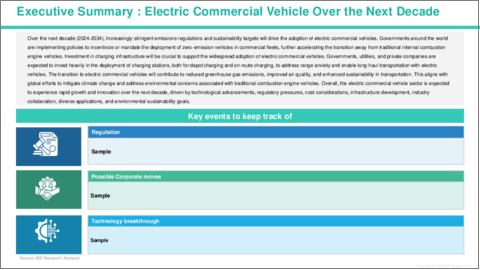|
|
市場調査レポート
商品コード
1469111
電気商用車の世界市場:用途別、車両タイプ別、推進タイプ別、航続距離別、地域別:分析と予測(2024年~2034年)Global Electric Commercial Vehicle Market: Focus on Application, Vehicle Type, Propulsion Type, Range, and Region - Analysis and Forecast, 2024-2034 |
||||||
カスタマイズ可能
|
|||||||
| 電気商用車の世界市場:用途別、車両タイプ別、推進タイプ別、航続距離別、地域別:分析と予測(2024年~2034年) |
|
出版日: 2024年04月24日
発行: BIS Research
ページ情報: 英文 100 Pages
納期: 1~5営業日
|
- 全表示
- 概要
- 目次
電気商用車分野は、世界的にますます厳しくなる排出ガス規制、政府によるインセンティブ、税額控除、補助金、電気自動車用バッテリーのコスト低下などに後押しされ、大きな成長を遂げています。
楽観的シナリオを考慮すると、2024年の市場規模は899億5,000万米ドルになるとみられ、今後は20.13%のCAGRで拡大し、2034年には5,631億3,000万米ドルに達すると予測されています。
| 主要市場統計 | |
|---|---|
| 予測期間 | 2024年~2034年 |
| 2024年評価 | 899億5,000万米ドル |
| 2034年予測 | 5,631億3,000万米ドル |
| CAGR | 20.13% |
こうしたプラスの要因にもかかわらず、市場は十分な充電インフラの不足や、従来型車両に比べて電気商用車の初期コストが高いといったハードルに直面しています。しかし、電気商用車に自律走行技術やコネクテッド技術が統合されることで、電気商用車の需要拡大に有利な機会がもたらされ、長距離路線を運行するフリートオペレーターにとっての航続距離への懸念や大型貨物輸送への適合性といった課題を克服しながら、この市場の活気ある将来を示唆しています。
アジア太平洋の電気商用車市場は著しい成長を遂げています。中国、インド、日本、韓国を含むアジア太平洋地域の多くの国々が、商用車を含む電気自動車(EV)の採用を促進するための政策やインセンティブを実施しています。こうした政策には通常、排出量削減と持続可能な輸送ソリューションの促進を目的とした補助金、税制優遇措置、規制措置が含まれます。
当レポートでは、世界の電気商用車市場について調査し、市場の概要とともに、用途別、車両タイプ別、推進タイプ別、航続距離別、地域別の動向、および市場に参入する企業のプロファイルなどを提供しています。
目次
エグゼクティブサマリー
第1章 市場:業界の展望
- 動向:現在および将来の影響評価
- サプライチェーンの概要
- 規制状況
- ステークホルダー分析
- 主要な世界的イベントの影響分析
- 市場力学の概要
- 市場の促進要因
- 市場の抑制要因
- 市場の機会
第2章 電気商用車市場(用途別)
- 用途のセグメンテーション
- 用途の概要
- 電気商用車市場(用途別)
第3章 電気商用車市場(製品別)
- 製品セグメンテーション
- 製品概要
- 電気商用車市場(車両タイプ別)
- 電気商用車市場(推進タイプ別)
- 電気商用車市場(航続距離別)
第4章 世界の電気商用車市場(地域別)
- 電気商用車市場(地域別)
- 北米
- アジア太平洋
- その他の地域
第5章 企業プロファイル
- 今後の見通し
- 地理的評価
- AB Volvo
- ARRIVAL UK LTD.
- BOLLINGER MOTORS INC.
- BYD
- Ford Motor Company
- General Motors
- Isuzu Motors Ltd.
- Mercedes-Benz AG.
- Nikola Corporation
- Proterra
- Rivian
- Scania
- Tesla
- VDL BUS & COACH BV
- Xos
- その他
第6章 調査手法
Introduction to Global Electric Commercial Vehicle Market
The electric commercial vehicle sector is experiencing significant growth, propelled by increasingly stringent emissions regulations worldwide, government incentives, tax credits, and subsidies, and decreasing costs for electric vehicle batteries. Considering the optimistic scenario, the market was valued at $89.95 billion in 2024 and is expected to grow at a CAGR of 20.13% to reach $563.13 billion by 2034.
| KEY MARKET STATISTICS | |
|---|---|
| Forecast Period | 2024 - 2034 |
| 2024 Evaluation | $89.95 Billion |
| 2034 Forecast | $563.13 Billion |
| CAGR | 20.13% |
Despite these positive drivers, the market faces hurdles such as a lack of adequate charging infrastructure and higher initial cost of electric commercial vehicles compared to conventional vehicles. However, the integration of autonomous and connected technologies in electric commercial vehicles presents lucrative opportunities for the expansion of electric commercial vehicle demand, suggesting a vibrant future for this market as it navigates through challenges toward range concerns for fleet operators operating long-haul routes and suitability for heavy-duty freight transportations.
The electric commercial vehicle market in the Asia-Pacific region is experiencing significant growth. Many countries in the Asia-Pacific region, including China, India, Japan, and South Korea, have implemented policies and incentives to promote the adoption of electric vehicles (EVs), including commercial vehicles. These policies typically include subsidies, tax incentives, and regulatory measures aimed at reducing emissions and promoting sustainable transportation solutions.
Companies such as General Motors Company, Tesla, and Volvo AB are at the forefront, offering a wide range of electric commercial vehicle products such as electric pickup trucks, electric buses, coaches, and electric vans, catering to a wide range of commercial and industrial applications. These companies play a crucial role in shaping the electric commercial vehicle market globally, offering electric commercial vehicles with robust design, electric powertrain, and towing capabilities. They also invest heavily in research and development to innovate new products, leveraging their expertise in automotive engineering, battery technology, and sustainable transportation solutions.
Governments and private companies in the Asia-Pacific region are investing in the development of charging infrastructure to support the growing number of electric vehicles on the road. The expansion of charging networks, including fast-charging stations along major transportation routes and in urban centers, is critical to the widespread adoption of electric commercial vehicles. In 2021, India initiated the Production Linked Incentive (PLI) Scheme for the National Program on Advanced Chemistry Cell (ACC) Battery Storage, aimed at bolstering the nation's manufacturing prowess in ACC production domestically. This initiative involved an allocation of $2.1 billion over a seven-year period, inclusive of a two-year gestation phase. Subsequent to this gestation period, incentives would be dispensed over the subsequent five years, contingent upon the sale of domestically manufactured batteries.
Market Segmentation:
Segmentation 1: by Application
- Industrial
- Mining and Construction
- Logistics
- Passenger Transportation
- Others
Segmentation 2: by Vehicle Type
- Pickup Trucks
- Medium Duty and Heavy-duty Trucks
- Vans (Light and Full-size Vans)
- Buses and Coaches
Segmentation 3: by Propulsion Type
- BEV
- Hybrid (PHEV, HEV, and FCEV)
Segmentation 4: by Range
- Below 200 Km
- 200-500 Km
- Above 500 Km
Segmentation 5: by Region
- North America
- Europe
- Asia-Pacific
- Rest-of-the-World
Key Market Players and Competition Synopsis
The companies that are profiled have been selected based on inputs gathered from primary experts and analyzing company coverage, type portfolio, and market penetration.
Some prominent names in the market include:
- AB Volvo
- General Motors
- Proterra
- Scania
- VDL BUS & COACH BV
Key Questions Answered
- What are the main factors driving the demand for electric commercial vehicle market?
- What are the major patents filed by the companies active in the global electric commercial vehicle market?
- Who are the key players in the global electric commercial vehicle market, and what are their respective market shares?
- What partnerships or collaborations are prominent among stakeholders in the global electric commercial vehicle market?
- What are the strategies adopted by the key companies to gain a competitive edge in electric commercial vehicle industry?
- What is the futuristic outlook for the electric commercial vehicle market in terms of growth potential?
- What is the current estimation of the global electric commercial vehicle market, and what growth trajectory is projected from 2024 to 2034?
- Which application, and product segment is expected to lead the market over the forecast period (2024-2034)?
- What could be the impact of growing end-use industries in the global electric commercial vehicle market?
- Which regions demonstrate the highest adoption rates for global electric commercial vehicle market, and what factors contribute to their leadership?
Table of Contents
Executive Summary
Scope and Definition
Market/Product Definition
Key Questions Answered
Analysis and Forecast Note
1. Markets: Industry Outlook
- 1.1 Trends: Current and Future Impact Assessment
- 1.2 Supply Chain Overview
- 1.2.1 Value Chain Analysis
- 1.2.2 Pricing Forecast
- 1.3 Regulatory Landscape
- 1.4 Stakeholder Analysis
- 1.4.1 Use Case
- 1.4.2 End User and Buying Criteria
- 1.5 Impact Analysis for Key Global Events
- 1.6 Market Dynamics Overview
- 1.6.1 Market Drivers
- 1.6.2 Market Restraints
- 1.6.3 Market Opportunities
2. Electric Commercial Vehicle Market (by Application)
- 2.1 Application Segmentation
- 2.2 Application Summary
- 2.3 Electric Commercial Vehicle Market (by Application)
- 2.3.1 Industrial
- 2.3.2 Mining and Construction
- 2.3.3 Logistics
- 2.3.4 Passenger Transportation
- 2.3.5 Others
3. Electric Commercial Vehicle Market (by Product)
- 3.1 Product Segmentation
- 3.2 Product Summary
- 3.3 Electric Commercial Vehicle Market (by Vehicle Type)
- 3.3.1 Pickup Trucks
- 3.3.2 Medium Duty and Heavy-duty Trucks
- 3.3.3 Vans (Light and Full-size Vans)
- 3.3.4 Buses and Coaches
- 3.4 Electric Commercial Vehicle Market (by Propulsion Type)
- 3.4.1 BEV
- 3.4.2 Hybrid (PHEV, HEV, and FCEV)
- 3.5 Electric Commercial Vehicle Market (by Range)
- 3.5.1 Below 200 Km
- 3.5.2 200-500 Km
- 3.5.3 Above 500 Km
4. Global Electric Commercial Vehicle Market (by Region)
- 4.1 Electric Commercial Vehicle Market (by Region)
- 4.2 North America
- 4.2.1 Regional Overview
- 4.2.2 Driving Factors for Market Growth
- 4.2.3 Factors Challenging the Market
- 4.2.4 Application
- 4.2.5 Product
- 4.2.6 U.S.
- 4.2.6.1 Market by Application
- 4.2.6.2 Market by Product
- 4.2.7 Canada
- 4.2.7.1 Market by Application
- 4.2.7.2 Market by Product
- 4.2.8 Mexico
- 4.2.8.1 Market by Application
- 4.2.8.2 Market by Product
- 4.3 Europe
- 4.3.1 Regional Overview
- 4.3.2 Driving Factors for Market Growth
- 4.3.3 Factors Challenging the Market
- 4.3.4 Application
- 4.3.5 Product
- 4.3.6 Germany
- 4.3.6.1 Market by Application
- 4.3.6.2 Market by Product
- 4.3.7 France
- 4.3.7.1 Market by Application
- 4.3.7.2 Market by Product
- 4.3.8 U.K.
- 4.3.8.1 Market by Application
- 4.3.8.2 Market by Product
- 4.3.9 Italy
- 4.3.9.1 Market by Application
- 4.3.9.2 Market by Product
- 4.3.10 Rest-of-Europe
- 4.3.10.1 Market by Application
- 4.3.10.2 Market by Product
- 4.4 Asia-Pacific
- 4.4.1 Regional Overview
- 4.4.2 Driving Factors for Market Growth
- 4.4.3 Factors Challenging the Market
- 4.4.4 Application
- 4.4.5 Product
- 4.4.6 China
- 4.4.6.1 Market by Application
- 4.4.6.2 Market by Product
- 4.4.7 Japan
- 4.4.7.1 Market by Application
- 4.4.7.2 Market by Product
- 4.4.8 India
- 4.4.8.1 Market by Application
- 4.4.8.2 Market by Product
- 4.4.9 South Korea
- 4.4.9.1 Market by Application
- 4.4.9.2 Market by Product
- 4.4.10 Rest-of-Asia-Pacific
- 4.4.10.1 Market by Application
- 4.4.10.2 Market by Product
- 4.5 Rest-of-the-World
- 4.5.1 Regional Overview
- 4.5.2 Driving Factors for Market Growth
- 4.5.3 Factors Challenging the Market
- 4.5.4 Application
- 4.5.5 Product
- 4.5.6 South America
- 4.5.6.1 Market by Application
- 4.5.6.2 Market by Product
- 4.5.7 Middle East and Africa
- 4.5.7.1 Market by Application
- 4.5.7.2 Market by Product
5. Companies Profiled
- 5.1 Next Frontiers
- 5.2 Geographic Assessment
- 5.2.1 AB Volvo
- 5.2.1.1 Overview
- 5.2.1.2 Top Products/Product Portfolio
- 5.2.1.3 Top Competitors
- 5.2.1.4 Target Customers
- 5.2.1.5 Key Personnel
- 5.2.1.6 Analyst View
- 5.2.1.7 Market Share
- 5.2.2 ARRIVAL UK LTD.
- 5.2.2.1 Overview
- 5.2.2.2 Top Products/Product Portfolio
- 5.2.2.3 Top Competitors
- 5.2.2.4 Target Customers
- 5.2.2.5 Key Personnel
- 5.2.2.6 Analyst View
- 5.2.2.7 Market Share
- 5.2.3 BOLLINGER MOTORS INC.
- 5.2.3.1 Overview
- 5.2.3.2 Top Products/Product Portfolio
- 5.2.3.3 Top Competitors
- 5.2.3.4 Target Customers
- 5.2.3.5 Key Personnel
- 5.2.3.6 Analyst View
- 5.2.3.7 Market Share
- 5.2.4 BYD
- 5.2.4.1 Overview
- 5.2.4.2 Top Products/Product Portfolio
- 5.2.4.3 Top Competitors
- 5.2.4.4 Target Customers
- 5.2.4.5 Key Personnel
- 5.2.4.6 Analyst View
- 5.2.4.7 Market Share
- 5.2.5 Ford Motor Company
- 5.2.5.1 Overview
- 5.2.5.2 Top Products/Product Portfolio
- 5.2.5.3 Top Competitors
- 5.2.5.4 Target Customers
- 5.2.5.5 Key Personnel
- 5.2.5.6 Analyst View
- 5.2.5.7 Market Share
- 5.2.6 General Motors
- 5.2.6.1 Overview
- 5.2.6.2 Top Products/Product Portfolio
- 5.2.6.3 Top Competitors
- 5.2.6.4 Target Customers
- 5.2.6.5 Key Personnel
- 5.2.6.6 Analyst View
- 5.2.6.7 Market Share
- 5.2.7 Isuzu Motors Ltd.
- 5.2.7.1 Overview
- 5.2.7.2 Top Products/Product Portfolio
- 5.2.7.3 Top Competitors
- 5.2.7.4 Target Customers
- 5.2.7.5 Key Personnel
- 5.2.7.6 Analyst View
- 5.2.7.7 Market Share
- 5.2.8 Mercedes-Benz AG.
- 5.2.8.1 Overview
- 5.2.8.2 Top Products/Product Portfolio
- 5.2.8.3 Top Competitors
- 5.2.8.4 Target Customers
- 5.2.8.5 Key Personnel
- 5.2.8.6 Analyst View
- 5.2.8.7 Market Share
- 5.2.9 Nikola Corporation
- 5.2.9.1 Overview
- 5.2.9.2 Top Products/Product Portfolio
- 5.2.9.3 Top Competitors
- 5.2.9.4 Target Customers
- 5.2.9.5 Key Personnel
- 5.2.9.6 Analyst View
- 5.2.9.7 Market Share
- 5.2.10 Proterra
- 5.2.10.1 Overview
- 5.2.10.2 Top Products/Product Portfolio
- 5.2.10.3 Top Competitors
- 5.2.10.4 Target Customers
- 5.2.10.5 Key Personnel
- 5.2.10.6 Analyst View
- 5.2.10.7 Market Share
- 5.2.11 Rivian
- 5.2.11.1 Overview
- 5.2.11.2 Top Products/Product Portfolio
- 5.2.11.3 Top Competitors
- 5.2.11.4 Target Customers
- 5.2.11.5 Key Personnel
- 5.2.11.6 Analyst View
- 5.2.11.7 Market Share
- 5.2.12 Scania
- 5.2.12.1 Overview
- 5.2.12.2 Top Products/Product Portfolio
- 5.2.12.3 Top Competitors
- 5.2.12.4 Target Customers
- 5.2.12.5 Key Personnel
- 5.2.12.6 Analyst View
- 5.2.12.7 Market Share
- 5.2.13 Tesla
- 5.2.13.1 Overview
- 5.2.13.2 Top Products/Product Portfolio
- 5.2.13.3 Top Competitors
- 5.2.13.4 Target Customers
- 5.2.13.5 Key Personnel
- 5.2.13.6 Analyst View
- 5.2.13.7 Market Share
- 5.2.14 VDL BUS & COACH BV
- 5.2.14.1 Overview
- 5.2.14.2 Top Products/Product Portfolio
- 5.2.14.3 Top Competitors
- 5.2.14.4 Target Customers
- 5.2.14.5 Key Personnel
- 5.2.14.6 Analyst View
- 5.2.14.7 Market Share
- 5.2.15 Xos
- 5.2.15.1 Overview
- 5.2.15.2 Top Products/Product Portfolio
- 5.2.15.3 Top Competitors
- 5.2.15.4 Target Customers
- 5.2.15.5 Key Personnel
- 5.2.15.6 Analyst View
- 5.2.15.7 Market Share
- 5.2.16 Others
- 5.2.1 AB Volvo






